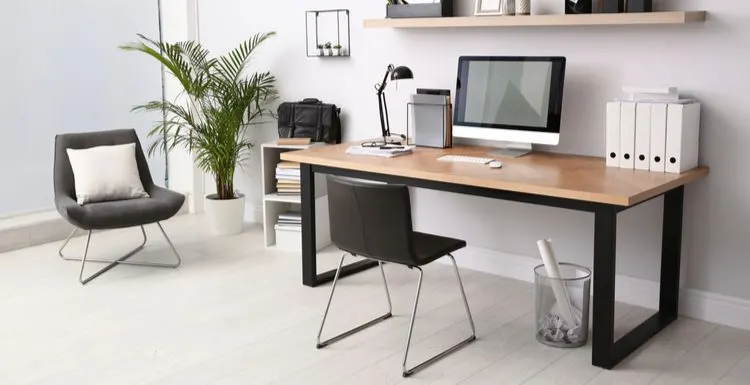Looking for a guide on standard desk dimensions?
We’ll cover the standard desk sizes by type, things that impact them, give you a few things to consider before buying, and more.
Read on to learn all you need to know.
Do Desk Dimensions Matter?
When setting up a workspace, your desk is one of the most important components. The size and placement of your desk can impact your productivity and your mood while working.
Depending on the space you have to work with, your desk dimensions should be harmonious within the room and give you enough surface space to store all your necessary items and not feel cramped while doing your work.
Today, we’ll go over how to choose the best-sized desk for you and how to make sure its placement in your room or office helps you be as productive as possible throughout your workday.
Minimum Desk Dimensions

eva_blanco/Shutterstock
Regardless of whether you prefer a larger or smaller desk, you’ll want to keep these minimum measurements in mind for several different desk configurations.
A sitting desk should give you at least 24 inches across to work from, as well as a 24-inch depth. When sitting, you should also consider the height of the desk.
To give you enough clearance for your knees, you should have at least 18 inches of depth, and the height clearance will be a little more subjective but should be around 21 inches high.
Also, consider that your laptop or monitor screen should be a minimum of 20 inches away from you while you work to minimize eye strain.
For a standing desk, a minimum surface width of 20 inches usually proves adequate. Since standing desks are typically for laptop work, the depth can be much smaller as long as it can accommodate your laptop.
Choosing Where the Desk Will Go
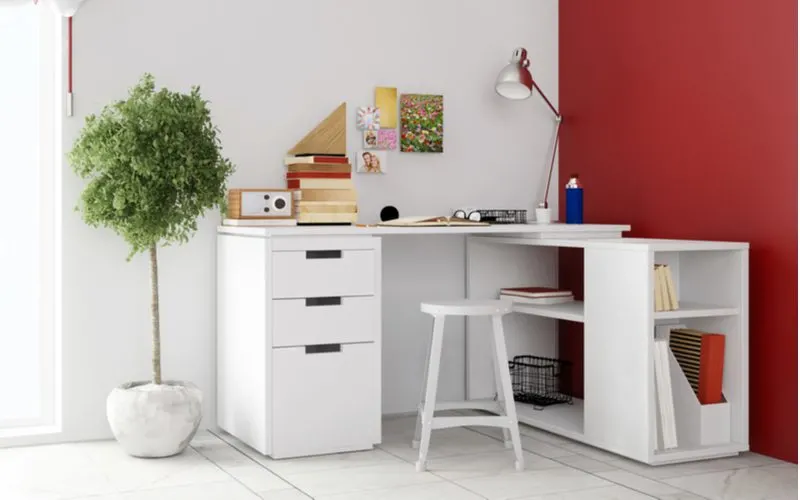
Robert Kneschke/Shutterstock
The above minimum dimensions are important when you start to consider where the desk will be positioned. Standing desks will require much less space, but traditional sitting desks are more popular and need a little more consideration.
Two common placements for desks, both sitting and standing ones, are either against the wall or free-standing. Your choice of placement will be greatly influenced by the size of the desk and the configuration of the room.
For example, if you want to place a single desk in a primarily open room, you will have less to consider than if you have multiple pieces of furniture, such as bookshelves or chairs, in the desired room already.
However, your choice of desk positioning should take into account more than just efficiency. If you plan to use your desk for long periods, such as for work-from-home situations, you should pick a spot that is comfortable and pleasing to you.
Finding a spot with some natural light, a calming view from a window, or other mood-boosting components is important.
However, these things aren’t always available, and sometimes the room you’re working in simply won’t allow for many options in your desk placement, which is fine.
Working With Tight Spaces
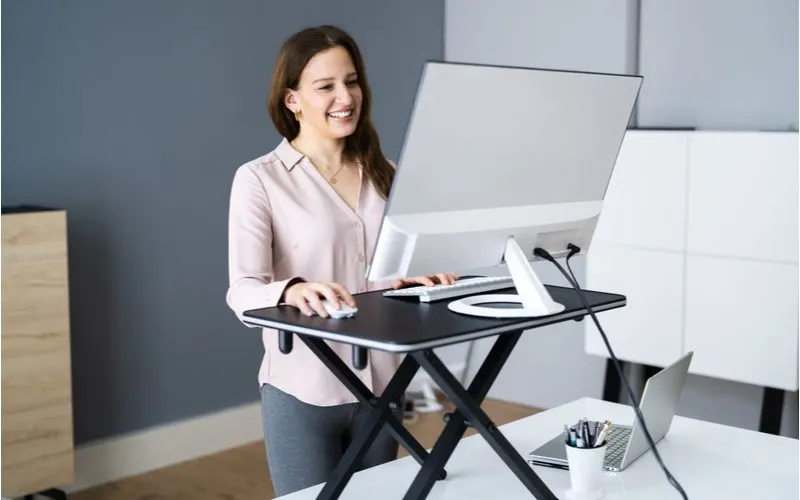
Andrey_Popov/Shutterstock
If you’re working in a challenging space that doesn’t offer many options, consider some of these ideas to help you maximize your space and create a productive work environment, even in a small area.
Workstation Configuration
In a small area, sometimes it’s best to take notes on how cubicles are arranged. You can fit a small desk with the minimum dimensions, or close to it, against a wall and then add more storage space around it to form a structured area.
With this configuration, it’s important to remember to leave enough clearance room for you to sit and lean back in your chair; a little over two feet is the minimum amount for comfort. Altogether, this workspace needs around 16 square feet of space.
You can also maximize the desk surface by adding a desk organizer or shelf that adds a second level for storage. Include cubbies, file cabinets, or shelves in the area around the desk to complete the workstation configuration.
Corner Desk Configuration
Using a corner desk is another great way to make the most of the space you have. With this option, you usually have more than enough surface space. If your desk has the optimal clearance space underneath, this opens up under-desk storage options.
Keeping in mind the space and clearance you’ll need when sitting at the desk, you can position file cabinets or shelves under the two sides of the desk.
With a corner desk, sometimes you lose workable space in the depth of the desk, which you can use more efficiently by placing shelves or organizers that add an upward surface area that is more easily accessible and used for storage.
Working With Larger Areas
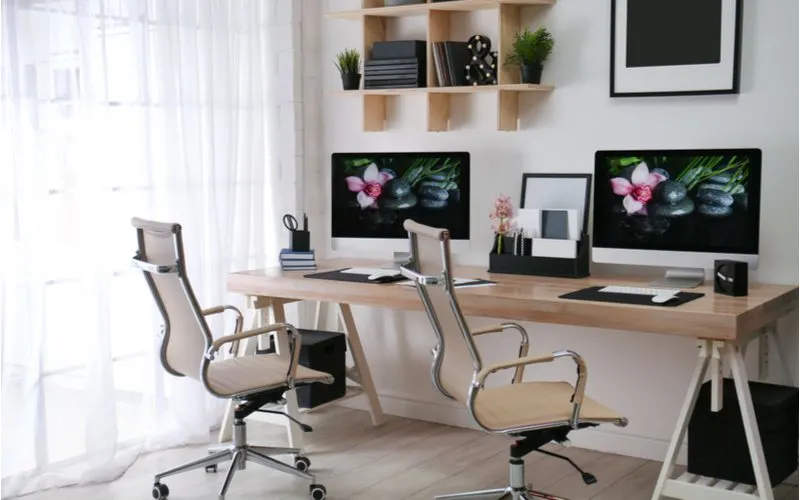
New Africa/Shutterstock
However, if you have a larger room that offers plenty of desk configuration options, you will be far less limited by your storage capabilities and even the style of desk that you choose.
You can feel free to move beyond the minimum dimensions and find a desk that genuinely suits you.
Office or Executive Desks
These types of desks usually offer more working surface area and take up more space within a room. These desks can be 60 by 30 inches, or sometimes even more extensive than that. These desks are often equipped with storage.
Because of the ample surface space, an executive or office desk is optimal for someone who needs to spread out while working. These desks can hold a computer or laptop and keyboard, a task lamp, filing trays, and even have space left over for writing.
These desks are an excellent option for people who want a multi-use office or home study desk that won’t feel cramped and will likely be the room’s focal point.
Because of their construction, they’re one of the better desks for positioning free-standing instead of only against a wall.
Computer Desks
For those who like the idea of an executive desk but don’t want something so bulky, a computer desk offers a decent amount of surface area while taking up less space in the room.
A definitive feature of these kinds of desks is a pull-out keyboard tray. They also usually have a built-in shelving or drawer system along one side under the desk.
These desks are a good option for makeshift workspaces that are not cramped but are perhaps not meant as long-term offices.
They can integrate well into a corner in a family room or bedroom and are unobtrusive. They are typically around 50 by 25 inches.
Two-Person Desks
Sometimes, multiple people need to share the same workspace. Typically, a two-person desk should be around 78 inches in length to accommodate two people and their supplies.
While two-person desks are available in one piece, it can also be convenient to use two desks together.
Using two long desks to form an L-shaped corner desk can sometimes work well for an office used by two people. In this case, you’ll need to keep minimum clearance dimensions in mind to make sure that both people can comfortably sit and then get out of their seats.
Whether you choose a one-piece desk or two for two people, adding shelves on the working surface is a good way to maximize your space so that under-desk clearance isn’t compromised with storage.
Anytime you add shelves to the desk surface, remember that you need a minimum depth of 24 inches to work comfortably with a computer or laptop.
So any desk that needs to accommodate shelves should have a minimum depth of around 34 inches to fit shelves and your workspace comfortably.
So, What Are Standard Desk Dimensions?
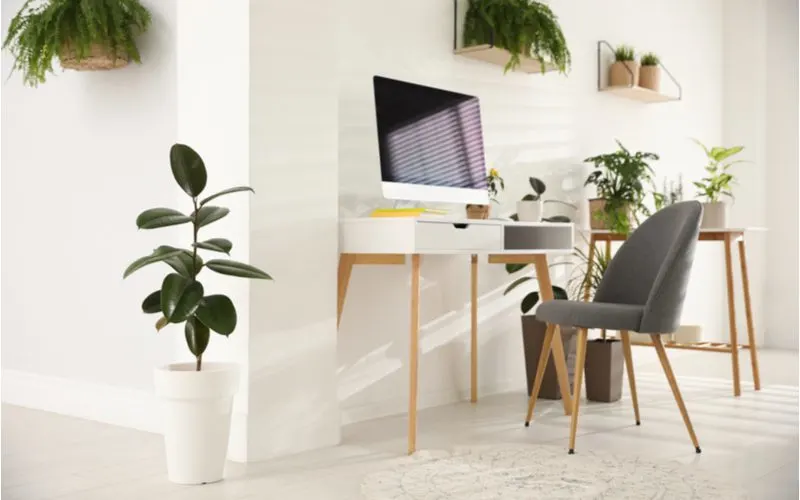
New Africa/Shutterstock
So there you have it—standard desk dimensions. When configuring your workspace, it’s important to work with what you have for maximum efficiency while also considering comfort.
Always make sure you have enough under-desk clearance when sitting down, enough clearance around you to scoot your chair back comfortably, and enough surface area in depth and width to accommodate your work without making you feel cramped or cluttered.
At the end of the day, the desk configuration that feels most comfortable will help you be your most productive.
Even if you’re working in a small space, you still have plenty of options for creating a space with your desk dimensions that make sense for your workflow.

